According to Fortune, OpenAI and Amazon have signed a $38 billion deal enabling the ChatGPT maker to run its AI systems on Amazon’s data centers in the U.S. The agreement announced Monday provides OpenAI access to “hundreds of thousands” of Nvidia’s specialized AI chips through Amazon Web Services, with Amazon shares increasing 4% following the announcement. The partnership comes less than a week after OpenAI altered its relationship with longtime backer Microsoft, which had been the startup’s exclusive cloud provider until early this year. OpenAI will immediately begin using AWS compute capacity, targeting full deployment before the end of 2026 with expansion potential into 2027 and beyond, while the company has recently made over $1 trillion in financial obligations for AI infrastructure projects. This massive infrastructure investment represents a strategic pivot with significant implications for the AI landscape.
The End of Cloud Exclusivity
OpenAI’s move to diversify beyond Microsoft Azure marks a critical inflection point in cloud computing strategy. For years, Microsoft’s exclusive arrangement provided OpenAI with both capital and infrastructure, but this new AWS partnership signals that single-provider dependency no longer serves OpenAI’s scaling ambitions. The timing is particularly telling—coming just days after regulatory approval for OpenAI’s new business structure that enables easier capital raising. This suggests OpenAI is preparing for massive expansion that requires multiple cloud partners to mitigate risk and ensure capacity availability. The era of AI companies being tied to single cloud providers appears to be ending as compute demands explode beyond what any single provider can guarantee.
The Trillion-Dollar Infrastructure Bet
What’s most striking about this deal isn’t just the $38 billion figure—it’s that this represents just one piece of OpenAI’s trillion-dollar infrastructure commitment. The business model here relies on what I’d call “forward capacity purchasing,” where cloud providers extend credit against future revenue expectations. This creates a circular financing model where providers essentially fund their own customers’ growth, betting that AI adoption will accelerate rapidly enough to justify these enormous commitments. The risk profile is unprecedented: OpenAI doesn’t currently turn a profit, yet it’s committing to infrastructure spending that dwarfs the GDP of many small nations. Sam Altman’s confidence in “steeply growing” revenue must materialize quickly to avoid a scenario where these obligations become unsustainable.
AWS’s Dual AI Strategy
Amazon’s position in this deal reveals a sophisticated hedging strategy. AWS now finds itself in the unusual position of backing both OpenAI and its direct competitor Anthropic, having previously made significant investments in Anthropic. This dual backing strategy allows Amazon to profit regardless of which AI architecture dominates, while simultaneously ensuring its cloud infrastructure remains central to the AI revolution. For Amazon, the $38 billion represents guaranteed revenue while strategically positioning AWS as the neutral infrastructure layer above the AI platform wars. This approach mirrors Microsoft’s strategy of investing across multiple AI companies while maintaining its Azure dominance.
The Coming AI Infrastructure Crunch
The scale of this deal—hundreds of thousands of Nvidia chips—highlights the severe supply constraints facing the AI industry. With OpenAI, Anthropic, Google, Microsoft, and countless smaller players all competing for the same limited supply of high-end AI chips, we’re witnessing an infrastructure arms race that could reshape the entire technology landscape. The timing of full deployment by end of 2026 suggests even Amazon, with its massive resources, needs years to provision the required capacity. This infrastructure bottleneck may ultimately determine which AI companies survive the next phase of development, as access to compute becomes more valuable than algorithms or talent alone.
The Profitability Paradox
The fundamental business question remains: when will these enormous infrastructure investments generate sustainable returns? OpenAI’s revenue growth must accelerate dramatically to cover not just this $38 billion AWS commitment but its entire trillion-dollar infrastructure portfolio. The company faces the challenge of monetizing AI services at a scale never before attempted, while competing against well-funded rivals offering similar capabilities. If AI adoption growth slows or if enterprise customers prove unwilling to pay premium prices for AI services, the entire house of cards could collapse. The success of this model depends on AI becoming as fundamental to business operations as electricity—anything less might not justify the staggering infrastructure costs.




